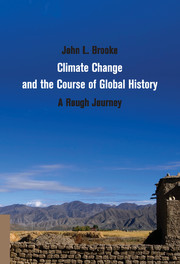Book contents
- Frontmatter
- Dedication
- Contents
- List of Figures and Tables
- Acknowledgments
- List of Abbreviations
- Introduction
- Part I Evolution and Earth Systems
- Part II Domestication, Agriculture, and the Rise of the State
- Part III Ancient and Medieval Agrarian Societies
- Part IV Into the Modern Condition
- 10 Climate, Demography, Economy, and Polity in the Late Medieval–Early Modern World, 1350–1700
- 11 Global Transformations: Atlantic Origins, 1700–1870
- 12 Launching Modern Growth: 1870 to 1945
- 13 Growth beyond Limits: 1945 to Present
- Coda
- Data Bibliography: Full Citations for Data Used in Figures and Tables
- Index
- References
11 - Global Transformations: Atlantic Origins, 1700–1870
Published online by Cambridge University Press: 05 August 2014
- Frontmatter
- Dedication
- Contents
- List of Figures and Tables
- Acknowledgments
- List of Abbreviations
- Introduction
- Part I Evolution and Earth Systems
- Part II Domestication, Agriculture, and the Rise of the State
- Part III Ancient and Medieval Agrarian Societies
- Part IV Into the Modern Condition
- 10 Climate, Demography, Economy, and Polity in the Late Medieval–Early Modern World, 1350–1700
- 11 Global Transformations: Atlantic Origins, 1700–1870
- 12 Launching Modern Growth: 1870 to 1945
- 13 Growth beyond Limits: 1945 to Present
- Coda
- Data Bibliography: Full Citations for Data Used in Figures and Tables
- Index
- References
Summary
During the three centuries since Thomas Savery launched his first steam engine, the forces of modernity have spread around the world with increasing power and complexity. Like the ripples in a pond spreading from a thrown rock, these forces have brought linked constellations of change to peoples across the entire planet, constellations with interlocking economic, demographic, and technological dimensions. The fundamental drivers of this process rest in the trajectory that European societies took during the early modern era: the rise of new dynamics of trade, state power, and empire building; the shift toward a lower-mortality demographic regime; and the consequences of the energy revolution that began at the end of the seventeenth century. The result was a transition from a world lightly populated by humanity and subject to essentially natural forces to a thickly populated world in which those human numbers and their economies now are playing an inexorable role in reshaping nature itself.
This history took an instant in geological time, but it has unfolded in a sequence of discrete processes and events that first unfolded relatively slowly, and then with an increasing and frightening acceleration, in which we can measure demographic doublings and atmospheric surges in the course of an incomplete lifetime. Thus in the 260 years between the announcement of Savery’s engine in 1698 and the first regular CO2 readings on Mauna Loa, Hawaii in 1958, when I was five years old, global population advanced from 680 million to 2.9 billion people, and CO2 in the atmosphere grew from a Little Ice Age low of roughly 278 ppm to 315 ppm. In 1974, when I traveled across Europe and much of Asia, these figures stood at 4 billion people and 330 ppm; now, in late 2013, they stand at 7.2 billion people and brushing up against 400 ppm. The methane readings are equally stunning and following the exact same trajectory (see Figure IV.3).
- Type
- Chapter
- Information
- Climate Change and the Course of Global HistoryA Rough Journey, pp. 467 - 499Publisher: Cambridge University PressPrint publication year: 2014

